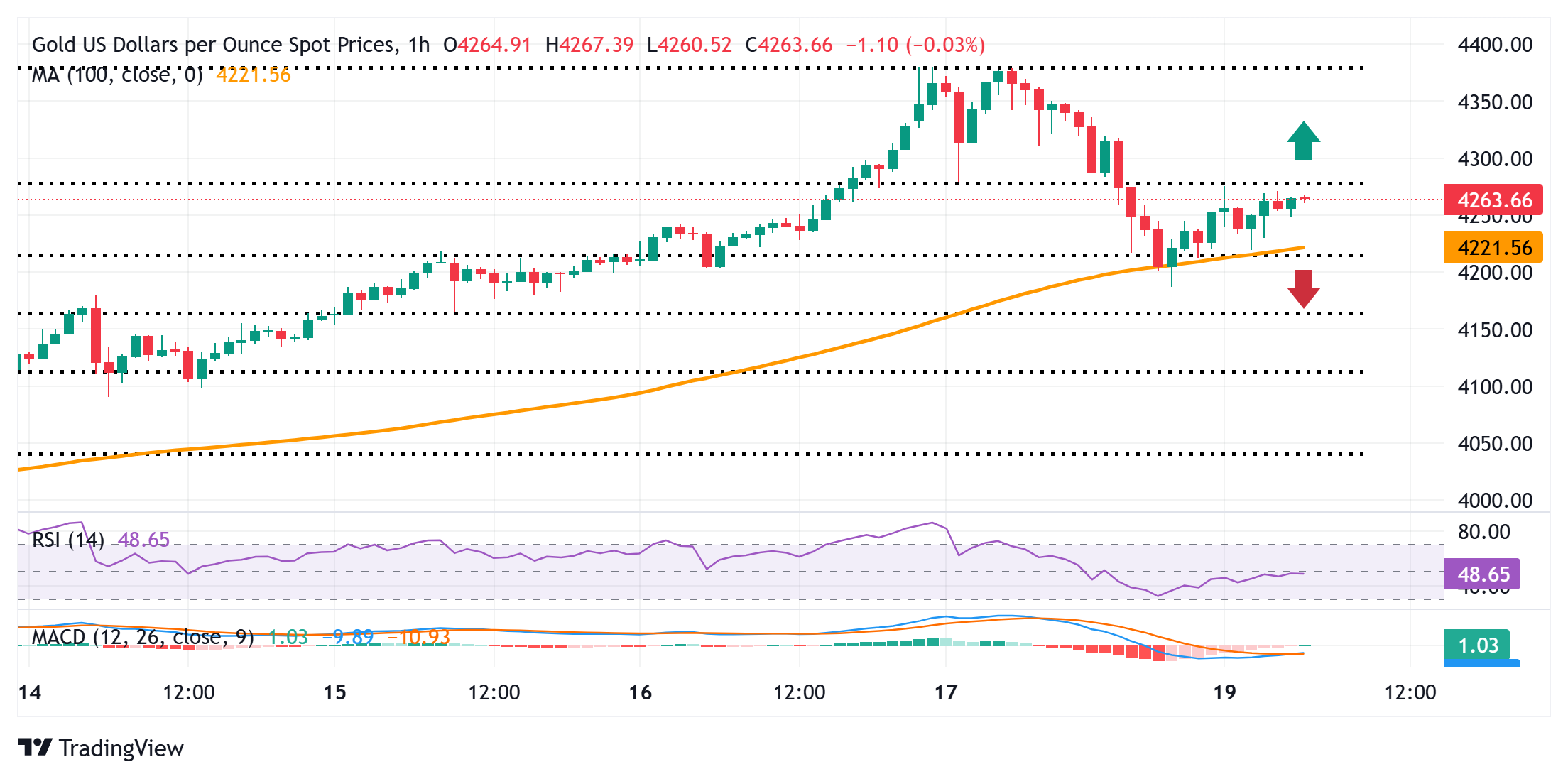Created
: 2025.10.20














![]() 2025.10.20 13:33
2025.10.20 13:33
Gold (XAU/USD) edges higher at the start of a new week and, for now, seems to have stalled its sharp retracement slide from the all-time peak, touched on Friday. Persistent trade-related uncertainties, rising geopolitical risks, and concerns that a prolonged US government shutdown would affect the economic performance continue to act as a tailwind for the safe-haven precious metal. Furthermore, dovish Federal Reserve (Fed) expectations underpin demand for the non-yielding yellow metal.
In fact, traders have fully priced in two more interest rate cuts by the US central bank this year, which fails to assist the US Dollar (USD) to capitalize on Friday's modest bounce. This, along with global fiscal concerns, central bank buying, and strong inflows into exchange-traded funds (ETFs), turns out to be another factor acting as a tailwind for Gold. Meanwhile, US President Donald Trump's comment on Friday eased concerns about an all-out US-China trade war and might cap the commodity.

From a technical perspective, the XAU/USD pair showed some resilience below the $4,210-$4,200 confluence on Friday - comprising the 100-hour Simple Moving Average (SMA) and the 38.2% Fibonacci retracement level of the October 9-17 rally. The subsequent move up, however, faces a hurdle near the 23.6% Fibo. retracement level, around the $4,275 region. The latter should now act as a pivotal point for intraday traders, above which the Gold could climb further beyond the $4,300 mark, towards the $4,325 horizontal resistance. The momentum could extend further towards retesting the all-time peak, around the $4,379-4,380 zone, touched on Friday.
On the flip side, the Asian session trough, around the $4,219-4,218 region could offer support to the XAU/USD pair ahead of the $4,200 round figure and Friday's swing low, around the $4,186 zone. Some follow-through selling below the $4,163-4,162 area, or the 50% retracement level, could make the Gold price vulnerable to accelerate the fall towards the $4,100 mark. The latter coincides with the 61.8% Fibo. retracement level, which, if broken decisively, will suggest that the commodity has topped out and pave the way for a deeper corrective decline.
Gold has played a key role in human's history as it has been widely used as a store of value and medium of exchange. Currently, apart from its shine and usage for jewelry, the precious metal is widely seen as a safe-haven asset, meaning that it is considered a good investment during turbulent times. Gold is also widely seen as a hedge against inflation and against depreciating currencies as it doesn't rely on any specific issuer or government.
Central banks are the biggest Gold holders. In their aim to support their currencies in turbulent times, central banks tend to diversify their reserves and buy Gold to improve the perceived strength of the economy and the currency. High Gold reserves can be a source of trust for a country's solvency. Central banks added 1,136 tonnes of Gold worth around $70 billion to their reserves in 2022, according to data from the World Gold Council. This is the highest yearly purchase since records began. Central banks from emerging economies such as China, India and Turkey are quickly increasing their Gold reserves.
Gold has an inverse correlation with the US Dollar and US Treasuries, which are both major reserve and safe-haven assets. When the Dollar depreciates, Gold tends to rise, enabling investors and central banks to diversify their assets in turbulent times. Gold is also inversely correlated with risk assets. A rally in the stock market tends to weaken Gold price, while sell-offs in riskier markets tend to favor the precious metal.
The price can move due to a wide range of factors. Geopolitical instability or fears of a deep recession can quickly make Gold price escalate due to its safe-haven status. As a yield-less asset, Gold tends to rise with lower interest rates, while higher cost of money usually weighs down on the yellow metal. Still, most moves depend on how the US Dollar (USD) behaves as the asset is priced in dollars (XAU/USD). A strong Dollar tends to keep the price of Gold controlled, whereas a weaker Dollar is likely to push Gold prices up.
![]()
Created
: 2025.10.20
![]()
Last updated
: 2025.10.20

FXStreet is a forex information website, delivering market analysis and news articles 24/7.
It features a number of articles contributed by well-known analysts, in addition to the ones by its editorial team.
Founded in 2000 by Francesc Riverola, a Spanish economist, it has grown to become a world-renowned information website.
We hope you find this article useful. Any comments or suggestions will be greatly appreciated.
We are also looking for writers with extensive experience in forex and crypto to join us.
please contact us at [email protected].
Disclaimer:
All information and content provided on this website is provided for informational purposes only and is not intended to solicit any investment. Although all efforts are made in order to ensure that the information is correct, no guarantee is provided for the accuracy of any content on this website. Any decision made shall be the responsibility of the investor and Myforex does not take any responsibility whatsoever regarding the use of any information provided herein.
The content provided on this website belongs to Myforex and, where stated, the relevant licensors. All rights are reserved by Myforex and the relevant licensors, and no content of this website, whether in full or in part, shall be copied or displayed elsewhere without the explicit written permission of the relevant copyright holder. If you wish to use any part of the content provided on this website, please ensure that you contact Myforex.
Myforex uses cookies to improve the convenience and functionality of this website. This website may include cookies not only by us but also by third parties (advertisers, log analysts, etc.) for the purpose of tracking the activities of users. Cookie policy